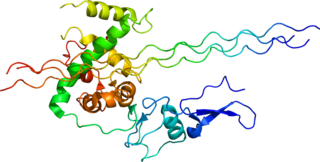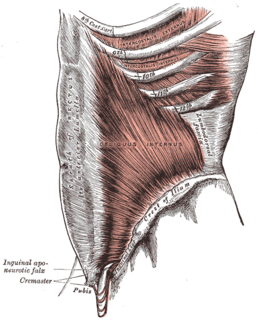
Ehlers–Danlos syndromes (EDS) are a group of genetic connective tissue disorders. Symptoms may include loose joints, joint pain, stretchy skin, and abnormal scar formation. These can be noticed at birth or in early childhood. Complications may include aortic dissection, joint dislocations, scoliosis, chronic pain, or early osteoarthritis. EDS is therefore a rheumatic and musculoskeletal disorder falling in the rheumatology specialty.

Adducted thumb syndrome recessive form is a rare disease affecting multiple systems causing malformations of the palate, thumbs, and upper limbs. The name Christian syndrome derives from Joe. C. Christian, the first person to describe the condition. Inheritance is believed to be autosomal recessive, caused by mutation in the CHST14 gene.

Darier's disease (DAR), is an autosomal dominant disorder discovered by French dermatologist Ferdinand-Jean Darier. Darier's is characterized by dark crusty patches on the skin, sometimes containing pus. The crusty patches are also known as keratotic papules, keratosis follicularis, or dyskeratosis follicularis.

Ectodermal dysplasia (ED) is not a single disorder but a group of syndromes all deriving from abnormalities of the ectodermal structures. More than 150 different syndromes have been identified.

A disintegrin and metalloproteinase with thrombospondin motifs 2 (ADAM-TS2) also known as procollagen I N-proteinase is an enzyme that in humans is encoded by the ADAMTS2 gene.

Collagen, type I, alpha 1, also known as alpha-1 type I collagen, is a protein that in humans is encoded by the COL1A1 gene. COL1A1 encodes the major component of type I collagen, the fibrillar collagen found in most connective tissues, including cartilage.
Hypermobility syndrome (HMS), Hypermobility Spectrum Disorder (HSD), or joint hypermobility syndrome (JHS) is a heritable connective tissue disorder that affects the joints and ligaments in a person's body. It comes in different degrees of severity, the least being similar to double-jointedness, but if it is progressively more serious it can create more problems for someone. These can include the inability to walk properly or for long distances, and pain in affected areas. In some cases, people with HMS are subjected to hypersensitive nerves and a weaker immune system. It also can have an effect on exhaustion levels and some cases cause depressive episodes.

Acrocephalosyndactylia is the common presentation of craniosynostosis and syndactyly.

Loeys–Dietz syndrome (LDS) is an autosomal dominant genetic connective tissue disorder. It has features similar to Marfan syndrome and Ehlers–Danlos syndrome. The disorder is marked by aneurysms in the aorta, often in children, and the aorta may also undergo sudden dissection in the weakened layers of the wall of the aorta. Aneurysms and dissections also can occur in arteries other than the aorta. Because aneurysms in children tend to rupture early, children are at greater risk for dying if the syndrome is not identified. Surgery to repair aortic aneurysms is essential for treatment.

Sack–Barabas syndrome is an older name for the medical condition Ehlers-Danlos syndrome, vascular type. It affects the body's blood vessels and organs, making them prone to rupture.

Type III Collagen is a homotrimer, or a protein composed of three identical peptide chains (monomers), each called an alpha 1 chain of type III collagen. Formally, the monomers are called collagen type III, alpha-1 chain and in humans are encoded by the COL3A1 gene. Type III collagen is one of the fibrillar collagens whose proteins have a long, inflexible, triple-helical domain.
Injection lipolysis is a controversial cosmetic procedure in which drug mixtures are injected into patients with the goal of destroying fat cells. This practice, using drugs generally based on phosphatidylcholine and deoxycholate (PCDC), evolved from the initial intravenous use of those drug formulations to treat blood disorders.

A member of the tenascin family, tenascin X (TN-X) also known as hexabrachion-like protein is a glycoprotein that is expressed in connective tissues including skin, joints and muscles. In humans, tenascin X is encoded by the TNXB gene.

Collagen alpha-1(V) chain is a protein that in humans is encoded by the COL5A1 gene.

Collagen alpha-2(V) chain is a protein that in humans is encoded by the COL5A2 gene.

Beta-1,4-galactosyltransferase 7 also known as galactosyltransferase I is an enzyme that in humans is encoded by the B4GALT7 gene. Galactosyltransferase I catalyzes the synthesis of the glycosaminoglycan-protein linkage in proteoglycans. Proteoglycans in turn are structural components of the extracellular matrix that is found between cells in connective tissues.

Carbohydrate sulfotransferase 14 is an enzyme that in humans is encoded by the CHST14 gene.

Porokeratosis is a specific disorder of keratinization that is characterized histologically by the presence of a cornoid lamella, a thin column of closely stacked, parakeratotic cells extending through the stratum corneum with a thin or absent granular layer.
Adult blaschkitis is a rare inflammatory skin condition presenting as pruritic papules and vesicles along multiple lines of Blaschko.
FKBP14 is a gene which codes for a structural protein named FKBP prolyl isomerase 14. This protein is believed to aid in the process of procollagen folding and is located in the endoplasmic reticulum that functions to process and transport proteins. Procollagens are collagen precursors located in the extracellular matrix that give tissues elasticity, strength, and support. This gene is involved in patterning the collagen structure. FKBP prolyl isomerase 14 may also be involved in altering other factors in the extracellular matrix. Mutations of this gene are associated with the kyphoscoliotic type of Ehlers-Danlos syndrome. This condition is characterized by a high range of joint movement, muscle atrophy, curved spine, and delicate cardiovascular vessels. These symptoms are brought about by a loss of the protein which results in a disruption of endoplasmic reticulum activities and extracellular matrix organization. FKBP14 mRNA levels are found higher in ovarian cancer tissues than healthy ovarian tissue and knocked down expression of FKBP14 by lentiviral shRNA leads to an impaired proliferative ability of ovarian cancer cells.















